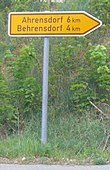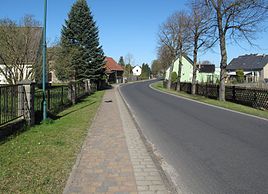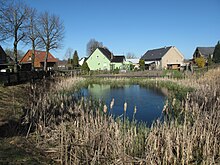Behrensdorf (Rietz-Neuendorf)
|
Behrensdorf
Community Rietz-Neuendorf
Coordinates: 52 ° 11 ′ 8 ″ N , 14 ° 3 ′ 2 ″ E
|
||
|---|---|---|
| Height : | 64 m | |
| Area : | 2.66 km² | |
| Residents : | 100 (Dec. 31, 2014) | |
| Population density : | 38 inhabitants / km² | |
| Incorporation : | 1st January 1974 | |
| Incorporated into: | Ahrensdorf | |
| Postal code : | 15848 | |
| Area code : | 033677 | |
|
Location of Behrensdorf in Brandenburg |
||
|
Lindenallee, central Dorfstrasse and part of Landesstrasse 422
|
||
Behrensdorf ( Baranojce in Lower Sorbian ) is a district of the municipality of Rietz-Neuendorf in the Oder-Spree district (Brandenburg). Behrensdorf was incorporated into the then neighboring community of Ahrensdorf in 1974 and has been its district ever since. After Ahrensdorf was incorporated into the municipality of Rietz-Neuendorf in 2001, Behrensdorf became part of Rietz-Neuendorf.
geography

Behrensdorf is about 13 kilometers west of Beeskow , about 11 km southeast of Storkow (Mark) and about 2 kilometers northwest of Ahrensdorf on the Beeskower Platte . The L 422 leads from Wendisch Rietz through the village to Ahrensdorf. In the village, a small road branches off towards the southwest to Limsdorf .
The western parts of the original 887 hectare area (1931), which are closer to Wendisch Rietz , were separated in 1945 and incorporated into Wendisch Rietz. Today's district borders in the north-east on Glienicke , in the south-east on Ahrensdorf, in the south on the Möllendorfer district Limsdorf and in the west and north-west on Wendisch Rietz.
There are no permanent watercourses in the Behrensdorf district, in the eastern part there are ditches with dry flowing watercourses . These include the Schwenowseegraben that, unless it is dry, its water over the Schwenowsee , Drobschsee and Blabbergraben the Krumme Spree supplies. The continuity of the Schwenowseegraben is to be restored as part of the Krumme Spree water development concept . The highest point is marked by a flat hill in the eastern part of the district, for the height of which the topographic map 1: 25,000 sheet 3850 (Kossenblatt) indicates 68 m. The lowest point is in the southeast corner of the district at just under 60 m.
history
Behrensdorf was first mentioned in a document in 1443 as Bernsdorf . The name is derived from the pet form of German personal names such as Bernhard, Bernwart etc. Bern = village of a man named Bern. The structure of the village clearly shows the layout of the place as an anger village . Said Anger is still there. Villages of this type were created during the German settlement in the east ; in the case of the establishment of "Bernsdorf", the time around 1200 can be deduced from the area around the village.
Ownership history
The village belonged to the Beeskow estate until 1443 . In that year Friedrich von Bieberstein pawned the Baltzer Jessir and his mother half of Behrensdorf. An exception to this was 10 days of annual farm duty. In 1448 half of the village came to Georg (Jürgen) von Bursewitz zu Niederlehme and his wife immediately received a documentary confirmation that she was entitled to the place as a personal property. In the same year Friedrich von Bieberstein enfeoffed Balthasar Wirchau with the court and four hooves in Behrensdorf. In 1454 Martin Schunemann, the husband of a widowed von Borsewitz, renounced half of the village of Behrensdorf as her guardian and guardian of his stepchildren. He was to raise his claim to the other half before Michaelmas day of the following year before the Lord of the Beeskow rulers, Wenzel von Bieberstein , on whom this half would otherwise fall home.
Apparently the village had actually reverted to the Beeskow rule. In 1454, half the village of Behrensdorf was prescribed to Hans Jessir for 20 shock groschen . In 1495, Erhardt von Koßpot , electoral Saxon bailiff in Beeskow, enfeoffed a Friedrich von Gera with a Freihof , four Hufen and a sheep farm in Behrensdorf. 1518 was the captain Harttwig plow / Plawen (Ihlow?) To Lebus a two hooves farmers in the area that is the house Storkow served . In 1463 and 1556 to 1599 the von Löschebrand received the lifting of a two-man in Behrensdorf. Already before 1522 Melchiot von Rottstock (Rathstock) had acquired the Freihof, the four Hufen and the sheep farm in Behrensdorf. In that year he sold these loan pieces to his liege lord, Bishop Dietrich von Lebus, for 203 guilders. In 1577, Johann Georg , Margrave and Elector of Brandenburg enfeoffed Clemens Ludwig with Behrensdorf. Until 1588 Behrensdorf had been sold to Wenzel von Bennewitz. On January 23, 1588, he received the approval of Elector Johann Georg to sell a field in Behrensdorf. The village later fell back to the office of Beeskow and was official property until 1872/4.
| Population development from 1774 to 1971 | |||||||||||||||||
|---|---|---|---|---|---|---|---|---|---|---|---|---|---|---|---|---|---|
| year | 1774 | 1801 | 1818 | 1837 | 1858 | 1875 | 1890 | 1910 | 1925 | 1939 | 1946 | 1950 | 1964 | 1971 | |||
| Residents | 86 | 79 | 98 | 124 | 164 | 173 | 150 | 134 | 175 | 167 | 208 | 203 | 155 | 133 | |||
Village history

In 1518 the Lehnschulze had six hooves under the plow, one farmer cultivated four hooves, another farmer 3.5 hooves, five farmers cultivated three hooves each and one farmer two hooves. In addition, two kossa families lived in the village, who operated part-time farming. In total, the village had 30.5 hooves. In 1537 the official share is given as one six-hoofed farmer, seven three-hoofed farmer and three kossaten. In 1576 nine farmers, three cottagers and one housekeeper lived in Behrensdorf. In 1600 there were 30 farmer's hooves. In 1639 Schulze and 12 other subjects gave grain interest to the Storkow office . In 1641 there were only four subjects left. In 1652 the Schulzengut was reoccupied with six hooves, as was a farm with 3.5 hooves. But two of five three-hoofed farms were desolate, and one of two single-hoofed farms was not yet occupied either. Of the four kossas, three cultivated one hoof each and one half a hoof. The desert fields were used by the other villagers. A shepherd lived in the community shepherd's house. In 1692 the condition of 1652 had become a permanent one. The desolate farms were no longer occupied and the hooves were distributed. One of the three large fields was designated as minor because it had sandy soil. The yield in the fields was comparatively low, the farmers "hardly harvested the 3rd grain". There were few meadows and inadequate herding , so that the inhabitants only kept a few sheep. But there was enough firewood for that. In 1727 33 hooves are mentioned, which were cultivated by 13 hoof farmers. In 1743 there were only 30 hooves. The Lehnschulze farmed six hooves, three farmers three hooves each, six Kossaten one hoof and two Kossaten one and a half hooves.
In 1775 there were 15 fire places in the village; Four farmers, eight Kossäts and three Büdner or others lived in the village, each with their families. The place had 86 inhabitants. In 1801, the population is broken down as follows: a Lehnschulze, three whole farmers, eight whole kossians, a granny and a blacksmith who lived in 16 campfire sites. At that time, Behrensdorf had 79 inhabitants. In the place was a secondary customs office, the field mark was divided into 33 Hufen. By 1837 the number of residential buildings rose to 20 houses and by 1858 to 21 houses, and 42 farm buildings were also in use. In 1864 a farmer had apparently been bought out and connected to the Lehnschulzengut. Around 1900 there were 23 residential buildings, in 1931 27 residential buildings. In 1939, two agricultural and forestry holdings cultivated over 100 hectares. There were nine farms between 20 and 100 hectares, six farms with 10 to 20 hectares, one farm with 5 to 10 hectares and six farms with 0.5 to 5 hectares.
After the Second World War, an estate was expropriated and 101 hectares were divided up as part of the land reform. Eight landless farm workers and landless peasants were given 34 hectares and nine resettlers 67 hectares. The second great good was converted into a people's own good . In 1956 the Agricultural Production Cooperative (LPG) Type III was founded. In 1960 it had 36 members in 18 companies and cultivated 211 hectares. A second LPG type I had five members on 42 hectares and was connected to LPG type III after 1965. In 1970 the LPG Ahrensdorf was connected to the LPG Type III Behrensdorf. Four years later the LPG Type III Behrensdorf was connected to the LPG Type III Limsdorf. From 1977 the management of the state-owned estate in Behrensdorf was transferred to the state-owned estate Lindenberg .
Political Affiliation
The place belonged to the original Lower Lusatian rule Beeskow. In 1518 the Beeskow reign came first as a pledge to the Bishop of Lebus . In 1556 the pledge was passed on to the Brandenburg (co-) elector Johann von Küstrin , who died in 1571. In 1575/6 the rule of Beeskow finally came to Brandenburg, but was a Bohemian fief until 1742. In the 17th and 18th centuries, the Beeskow-Storkow district was formed from the two lordships of Beeskow and Storkow , which was dissolved in 1815. The area of the former rule Beeskow was connected to the district of Lübben , the area of the former rule Storkow was combined with the Teltowic district to form the Teltow-Storkow district . In 1835 the division of the two dominions was reversed and the Beeskow-Storkow district was created . In a first district reform in 1950 in the then GDR, the Beeskow-Storkow district was dissolved again. The northern part - including Behrensdorf - came to the Fürstenwalde district . In 1952 the new Beeskow district was formed in the Frankfurt (Oder) district. After the fall of the Berlin Wall, the Beeskow district was renamed the Beeskow district . In 1992, Ahrensdorf and its district Behrensdorf merged with 12 other communities to form the Glienicke / Rietz-Neuendorf district. In 1993 the district of Beeskow was finally merged with the districts of Eisenhüttenstadt , Fürstenwalde and the independent city of Eisenhüttenstadt to form the Oder-Spree district . On December 31, 2001, Ahrensdorf, Birkholz, Buckow, Drahendorf, Görzig, Groß Rietz, Herzberg, Neubrück (Spree), Pfaffendorf, Sauen and Wilmersdorf merged to form the new municipality of Rietz-Neuendorf. On October 26, 2003, the last two municipalities, Alt Golm and Glienicke, were incorporated into the municipality of Rietz-Neuendorf by law and the Glienicke / Rietz-Neuendorf office was thus dissolved. The municipality of Rietz-Neuendorf has been vacant since then. Behrensdorf received the status of a district in the new municipality with its own local advisory board and local councilor. The local council consists of three members and elects the mayor from among its members. The incumbent mayor in 2015 is Cornelia Stotz.
Church affiliation
The place has no church and was always churched after Ahrensdorf.
Monuments and sights
The list of monuments of the State of Brandenburg for the Oder-Spree district lists a soil monument for Behrensdorf.
- No. 90602 village center German Middle Ages, village center modern times, settlement prehistory
supporting documents
literature
- Adolph Friedrich Riedel: Codex diplomaticus Brandenburgensis: Collection of documents, chronicles and other source documents. Part 1 (A) Vol. 20 516 pp., Reimer, Berlin 1861 Online at Google Books (hereinafter abbreviated to Riedel, Codex Diplomaticus Brandenburgensis, A 20, with the corresponding page number)
- Joachim Schölzel: Historical local dictionary for Brandenburg. Part IX Beeskow-Storkow. 334 p., Hermann Böhlaus successor, Weimar 1989 ISBN 3-7400-0104-6 (hereinafter Schölzel, Historisches Ortslexikon, Beeskow-Storkow, page number).
Individual evidence
- ^ Behrensdorf on the website of the municipality of Rietz-Neuendorf
- ↑ Main statutes of the community of Rietz-Neuendorf from February 9, 2009 PDF
- ↑ a b Schölzel, Historisches Ortslexikon Beeskow Storkow, p. 5/6.
- ^ Sophie Wauer (after preliminary work by Klaus Müller): Brandenburgisches Namenbuch Part 12 The place names of the Beeskow-Storkow district. 269 pp., Franz Steiner Verlag, Stuttgart 2005, ISBN 3-515-08664-1 , p. 44
- ^ Paul Rogalla von Bieberstein, Albert Hirtz, Julius Helbig: Documentary contributions to the history of the noble lords of Biberstein and their goods. VII, 498 p., Association for local history of the Jeschken-Isergau, Reichenberg in German Bohemia, 1911 Online University of Regensburg (p. 104)
- ↑ a b c d e f g h i Friedrich Beck: Document inventory of the Brandenburg State Main Archives - Kurmark, 2: Municipal institutions and noble lords and goods. VII, 820 pp., Berlin, Berlin-Verl. Spitz 2002 ISBN 3830502923 (also publications of the Brandenburg State Main Archive Potsdam 45), p. 509/10.
- ^ Riedel, Codex Diplomaticus Brandenburgensis, A 20, p. 417 Online at Google Books
- ↑ Contribution to statistics. State Office for Data Processing State of Brandenburg Statistics. Historical municipality register of the state of Brandenburg 1875 to 2005 19.9 District Oder-Spree PDF
- ↑ Cornelia Stotz
- ↑ List of monuments of the state of Brandenburg: Landkreis Oder-Spree (PDF) Brandenburg State Office for Monument Preservation and State Archaeological Museum



